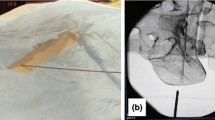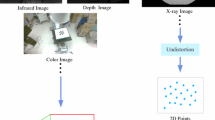Abstract
Purpose
The camera-augmented mobile C-arm (CamC) augments any mobile C-arm by a video camera and mirror construction and provides a co-registration of X-ray with video images. The accurate overlay between these images is crucial to high-quality surgical outcomes. In this work, we propose a practical solution that improves the overlay accuracy for any C-arm orientation by: (i) improving the existing CamC calibration, (ii) removing distortion effects, and (iii) accounting for the mechanical sagging of the C-arm gantry due to gravity.
Methods
A planar phantom is constructed and placed at different distances to the image intensifier in order to obtain the optimal homography that co-registers X-ray and video with a minimum error. To alleviate distortion, both X-ray calibration based on equidistant grid model and Zhang’s camera calibration method are implemented for distortion correction. Lastly, the virtual detector plane (VDP) method is adapted and integrated to reduce errors due to the mechanical sagging of the C-arm gantry.
Results
The overlay errors are 0.38±0.06 mm when not correcting for distortion, 0.27±0.06 mm when applying Zhang’s camera calibration, and 0.27±0.05 mm when applying X-ray calibration. Lastly, when taking into account all angular and orbital rotations of the C-arm, as well as correcting for distortion, the overlay errors are 0.53±0.24 mm using VDP and 1.67±1.25 mm excluding VDP.
Conclusion
The augmented reality fluoroscope achieves an accurate video and X-ray overlay when applying the optimal homography calculated from distortion correction using X-ray calibration together with the VDP.
Similar content being viewed by others
References
Azuma RT (1997) A survey of augmented reality. Teleoper Virtual Environ 6(4): 355–385
Shuhaiber JH (2004) Augmented reality in surgery. Arch Surg 139(2): 170–174
Nikou C, Digioia AM, Blackwell M, Jaramaz B, Kanade T (2000) Augmented reality imaging technology for orthopaedic surgery. Operat Tech Orthop 10(1): 82–86
Rolland JP, Wright DL, Kancherla AR (1997) Towards a novel augmented-reality tool to visualize dynamic 3D anatomy. Proc Med Meets Virtual Real 39: 337–347
Navab N, Mitschke M, Schütz O (1999) Camera-augmented mobile C-arm (CAMC) application: 3D reconstruction using a low-cost mobile C-arm. MICCAI 1679(1999): 688–697
Navab N, Heining SM, Traub J (2010) Camera augmented mobile C-Arm (CAMC): calibration, accuracy study, and clinical applications. IEEE Trans Med Imaging 29(7): 1412–1423
Wang L, Landes J, Weidert S et al (2010) First animal cadaver study for interlocking of intramedullary nails under camera augmented mobile C-arm. A surgical workflow based preclinical evaluation. In: Proceedings of IPCAI, lecture notes in computer science, vol 6135/2010, pp 56–66
Nicolau S, Lee PY, Wu HS et al (2011) Fusion of C-arm X-ray image on video view to reduce radiation exposure and improve orthopedic surgery planning: first in-vivo evaluation. In: Proceedings of 15th annual conference of the international society for computer aided surgery. Computer assisted radiology and surgery
Wang L, Traub J, Weidert S, Heining SM, Euler E, Navab N (2010) Parallax-free intraoperative X-ray image stitching. Med Image Anal 14(5): 674–686
Navab N, Wiesner S, Benhimane S, Euler E, Heining SM (2006) Visual servoing for intraoperative positioning and repositioning of mobile C-arms. MICCAI 9(1): 551–560
Zhang Z (2000) A flexible new technique for camera calibration. IEEE Trans PAMI 22(11): 1330–1334
Groher M (2003) Development of a planning and navigation tool for endoscopic treatment of aortic aneurysms-computer supported implantation of a stent graft. PhD thesis. Fakultät für Informatik, Technische Universität München
Yaniv Z, Joskowicz L, Simkin A (1998) Fluoroscopic image processing for computer-aided orthopedic surgery. In: MICCAI. Lecture notes in computer science, vol 1496, pp 325–334
Shechter G (2004) Respiratory motion of the heart: implications for magnetic resonance coronary angiography. PHD thesis, Johns Hopkins University
Fahrig R, Holdsworth DW (2000) Three-dimensional computed tomographic reconstruction using a C-arm mounted XRII: correction of the image intensifier distortion. Med Phys 27(30): 9
Chen X, Wang LJ, Fallavollita P, Navab N (2012) Error analysis of the X-ray projection geometry of camera-augmented mobile C-arm. Proc SPIE 8316: 83160
Yaniv Z (2004) Long bone panoramas from fluoroscopic X-Ray images. IEEE Trans Med Imaging 23(1): 26–34
Rampersaud YR, Simon DA, Foley KT (2001) Accuracy requirements for image-guided spinal pedicle screw placement. Image-Guid Surg 26(4): 352–359
Wang L, Fallavollita P, Zou R, Chen X, Weidert S, Navab N (2012) Closed-form inverse kinematics for interventional C-arm X-ray imaging with six degrees of freedom: modeling and application. IEEE Trans Med Imaging (to appear)
Author information
Authors and Affiliations
Corresponding author
Rights and permissions
About this article
Cite this article
Chen, X., Wang, L., Fallavollita, P. et al. Precise X-ray and video overlay for augmented reality fluoroscopy. Int J CARS 8, 29–38 (2013). https://doi.org/10.1007/s11548-012-0746-x
Received:
Accepted:
Published:
Issue Date:
DOI: https://doi.org/10.1007/s11548-012-0746-x




